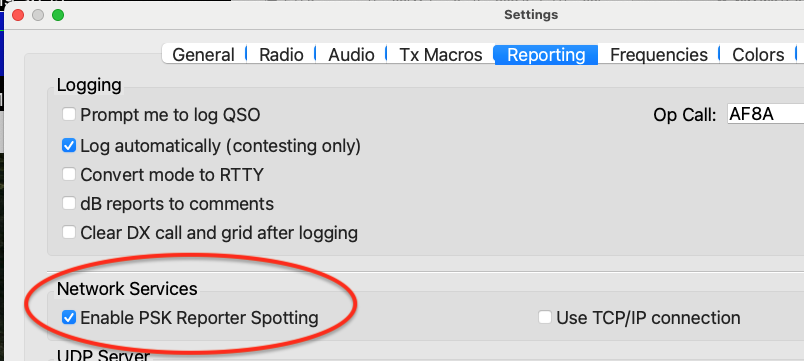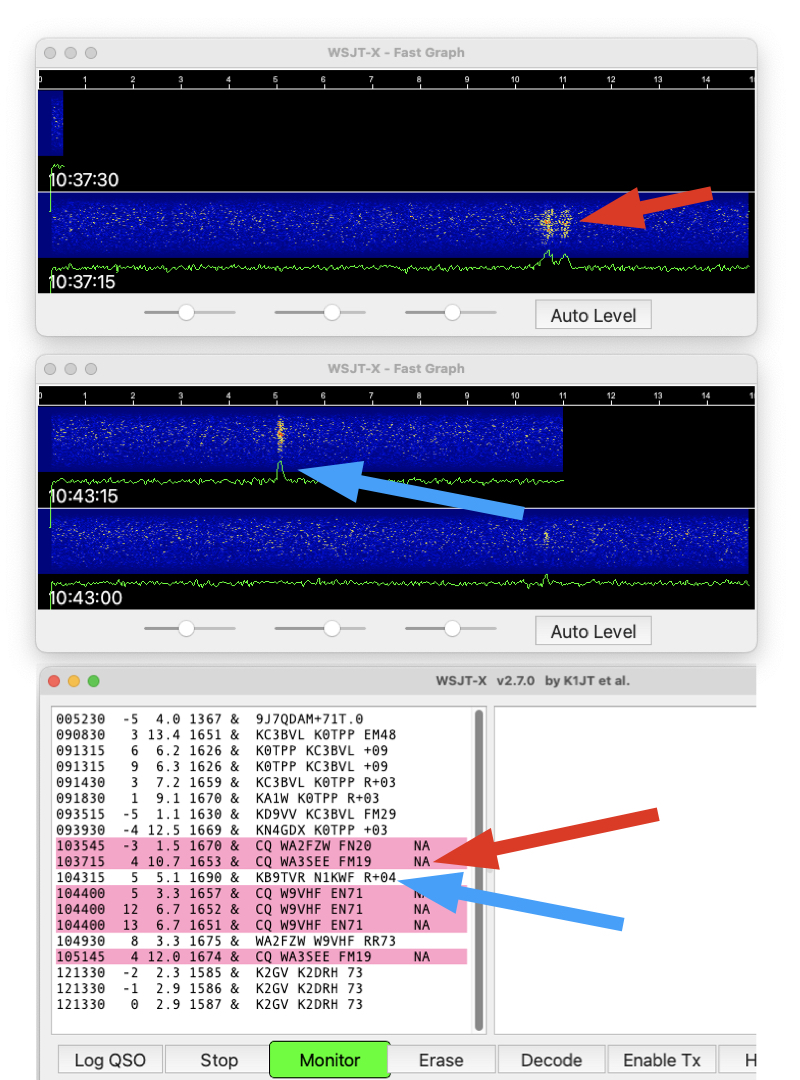HamSCI Meteor Scatter QSO Party

Work the rocks! Decode the pings!
Aug 11-12 and Dec 12-13, 2025
-
Contribute to science as we strive to uncover the secrets of meteor scatter (MS) propagation
-
Join hundreds of operators on 6 and 10 meter MSK144 during the August Perseid and December Geminid meteor showers
-
Two-Way (transmit/receive) and Monitor (receive only) stations are needed
-
Sending reception reports to PSKReporter is important to the success of these events. See the Software Setup section for details
-
Enter the MSQP Competition - Who makes the most QSOs or generates the most reception reports? See the MSQP Rules and Operating Guidelines.
MSK144 Is Just as Easy as Operating FT8, PSK31 or JT65
A typical meteor scatter (MS) station consists of a modern HF transceiver (IC7300, FT991, K3, Omni VII, etc.), a computer running WSJT-X, and, in some cases, a sound card interface. This is the exact same gear as is used by thousands of hams to runs FT8 and the other 'JT modes'. Antennas can be as simple as an attic dipole. Or, use a yagi, Hexbeam, quad or Moxon if you have one. (A gain antenna is always helpful - but beware of 'long boom' yagis, having very narrow beam widths, as they can be difficult to aim in a shower.)
MS activity is not limited to the major shower events - feel free to review the materials here, review the sites in the Additional Info section below, and get on the air (typically in the early morning hours, starting before sunrise though an hour or two after sunrise (soon after the sun rises, other propagation modes, such as E-skip or F2, often dominate the bands). Activity will be found on 50.260 and 28.145 MHz, using the MSK144 mode,
Software Setup: WSJT-X (Windows, Linux and Mac OS)
If you've never run WSJT or the other 'JT' modes: Download WSJT-X from the SourceForge website . Install per the User Documentation
Once it is up and running, you should be able to modify the settings (configuration) according to your needs. Simply 'accept' many of the checkboxes on the setup screens. Particularly important settings are noted below. Note that there is a groups.io forum dedicated to WSJT-X. That's the best place to ask questions, get help, etc. In fact, most questions may already have been answered and can be found by using the 'Search' function once you are on that groups.io page. The WSJTGROUP is friendly and they are especially good at solving connection issues to various radios.
Of particular importance to the MSQP event (especially for Monitors, those entering the event as receive-only) is to enable PSKReporter Spotting. Turning on this functionality sends all of your reception reports to the PSKReporter.info website. That's critical because after the MS events, HamSCI researchers will be downloading those reports, looking for interesting patters in the reception data. Their efforts will be most worthwhile if everyone who is on the air, whether transmitting or receiving, uploads their MS 'spots'. Once this is enabled, no further effort is required - it happens in the background (assuming your computer is connected to the Internet) with no effort on your part. Hint: Don't forget to find and click on the 'OK' button in this screen, to make sure your new settings are saved.

Other WSJT-X settings unique to the MSK144 mode:
- Special operating activity (NA VHF) Yes/No? NO
- Mode: MSK144
- Decode (Fast, Normal, Deep) DEEP if your CPU can handle it
- Tx even/1st (marked or unmarked) CQing to the West unmarked, CQing to the East marked
- Tx F Tol (number) 200 if your CPU can handle it
- Rx Hz (number) Rx 1500 Hz
- Report (number) Will be filled in automatically when you call someone
- T/R seconds (number) 15 s
- Sh (marked or unmarked) Unmarked
- Auto Seq (marked or unmarked) User preference
Audio Recordings of Decoded Pings
HamSCI is all about research - and doing good research requires good data - the more, the better. In addition to collecting QSO data (from ADIF files and downloads from the PSKReporter website) HamSCI would like to collect WAV files of decoded pings. It is very easy to save WAV files when you are running WSJT-X: Simply pull down the Save menu from the top of the screen, choose Save Decoded. WAV files will now be stored in your local hard drive. (You can find them by using the File - Open Log Directory menu path.). The MSQP Rules and Operating Guidelines will explain how, after the MS events, you can transfer the files from your computer to a secure storage area for later use by researchers.
Operating Hints and Additional Resources from Experienced MS Operators
Visit MS oriented websites, such as K5ND.net. Check out the VIRGO.EXE application for meteor sky view visualization.
Join the HamSCI Google Group, participate in the HamSCIence Zoom telecons (or view recordings on HamSCI's YouTube Channel) when MSQP discussions occur.
Listen and see if you can decode meteor scatter MSK144 pings. Listen on 50.260 MHz and 144.500 MHz, with WSJT-X MSK144 settings as: Rx 1500 Hz, FTOL 200, T/R 15S
On your transceiver, set your USB data filters as wide as they go. On my TS590SG I have them set to 3000 Hz.
A good time to listen is around 7 AM to 9 AM local time.
The upper MSK144 window is a 15 second time slot.
The bottom MSK144 window is the normal decode and control window.
On the web, go to Ping Jockey Central, and just watch the conversations as to who is scheduling who and comments on the meteor scatter conditions. When two stations are in process of trying to make a QSO, they will post their status as “running”. As a side note, on the upper right, there is a link called splat-65 Link. This is another chat group for using modes like JT65, Q65, MSK144 terrestrially.
Use your directional antenna and 100W to 200W on 6M and around 400W on 2M. If you have a very high gain directional antenna, like an EME setup, the beam will be too narrow. As a side note, I have also worked MSK144 meteor scatter using a dipole. The idea is basically you want a broader directional beam with good power to try and catch multiple meteor trails.
On DXMaps.com, go to your area and band, and look for blue QSO path lines – these are meteor scatter contacts. It gives an idea how many QSOs are happening. During a meteor shower, there will be many blue lines.
When a ping is detected, it will just look like a fast spike in the upper MSK144 window and it should decode immediately in the lower MSK144 window. Unlike modes like FT8 that need the almost full 15 seconds to transmit and then decode, MSK144 sends multiple repeated 73ms binary message chunks in the 15 second window, hoping that one or more message chunk will reflect off of a meteor ionized trail.
The higher the frequency, that harder to work meteor scatter. On 50.260 MHz running around 100W (200W is better) and a beam or Moxon, meteor scatter works pretty good. On 144.500 MHz it is much more difficult. 400W works much better and you will hear stations calling CQ Contest. There is no contest – they are using the contest mode to shorten the QSO time and they also have Sh (Short) set to have shorter bursts.
Folks follow a convention as to not to QRM other local stations and so multiple stations can operate on the same frequency, let’s say, 50.260 MHz. WSJT-X has a setting when you can call CQ on the calling frequency (50.260 or 144.150) and listen and make the QSO on another frequency. To do that: Put a frequency into WSJT-X for MSK144, let’s say at 50.270 MHz. Then go to that frequency. Then check the box that says Tx CQ 260. Then enable transmit. Your CQ will then also show the 270 in the CQ when transmitting on 260 and when another station double clicks on you, they will call you on 270 even though they heard you on 260 and you will reply back on 270.
For good meteor scatter conditions, you will only see pings in the upper MSK144 window when listening in your Rx time slot. If you also listen in your Tx time slot, you will see a full 15 second buzz signal fill the time slot from any other local stations. If you see a full buzz signal in your Rx time slot – it is most likely a farther out station being seen via tropo or Es. Or it could be another local station in the wrong time slot. Sporadic E and TROPO are sources of QRM when doing meteor scatter communications.
Now what if you are not decoding any pings? For MSK144 you must be VERY FREQUENCY ACCURATE, within 200 Hz, The widest FTOL you can use is 200 Hz. When I had an ICOM 746PRO, it worked fine for 6M but would not decode any pings on 2M. To solve that problem, I put in a TCXO and set it up with a frequency counter. My TS590SG worked fine on 6M meteor scatter as-is, but while I was at it, I also put a TCXO into the TS590SG. My ICOM 9700 decodes 2M meteor scatter as-is.
Hopefully the above info will be of use as you start to get into meteor scatter. One side note – unlike FT8, when you call back a station, you have to double click on that station and under sparse meteor conditions, a QSO could take a half hour or more. So, you can start the QSO, and then go make breakfast!
Sample Signals
Copied on 10 meters, 5 Apr 2025, at 10:37:15 and 10:43:15 UTC by an MSK144 / Meteor Scatter 'Rookie' (Omni VII, indoor attic dipole, WSJT-X).
Note that the WSJT-X User Documentation has information on how to download, and listen to, sample MSK144 signals.
Opening Image credit: Vikki Lawhon, MFA, University of Scranton. Remainder, Gary Mikitin, AF8A

